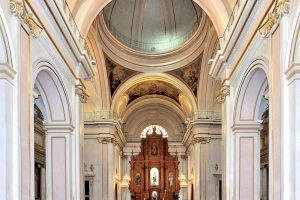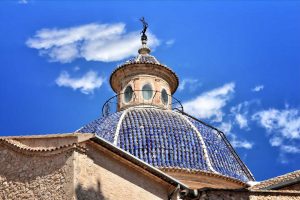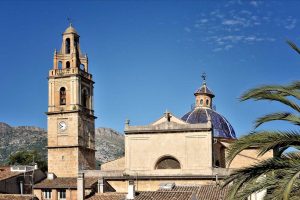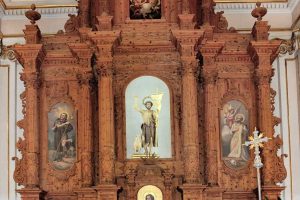The Church of San Juan Bautista located in the old town of Muro del Alcoy. The local festivities begin and end there. The Virgen de los Desamparados is moved during the holidays from her hermitage to the parish church, where she remains for 15 days to be venerated and worshipped by the devout neighbours of the town.
It was a Renaissance style building with a single vaulted nave, with four chapels on each side and two sacristies between which stood the high altar. The arches were made of brick and the corners and main entrance were made of carved stone with mouldings. That temple was in use until the construction of the current parish, of neoclassical style, starting in 1827 and inaugurated in 1837, being its architect Fray Vicente Cuenca.
As part of the construction project of the temple, there was the altarpiece of the main altar, which in addition to the part destined for painting should have some sculptural figures that would finish off the whole, some angels in the central part and statues of Adam and Eve in the corners. As for the painting of the altarpiece, it was made during the years 1604 to 1607 by Jerónimo Rodríguez de Espinosa, helped by Jaime Terol as decorator. They made up the total set of nine panels, five of which are in the Diocesan Museum and the whereabouts of the rest are unknown. Today, the Museum of the Cathedral of Valencia houses five panels that form part of the main altarpiece of the old church of Muro, which is in a poor state of conservation, due in part to the fire that the Archbishop’s Palace suffered during the civil war. The technique used by the painter is a greasy tempera on board. The measures of the boards are similar, about 153 * 99’5cm; they are composed of four boards arranged lengthwise with three crosspieces arranged lengthwise to reinforce the joints. The boards have a covering of tow and animal glue for the front and back.
At present, the altarpiece shows the Virgin of the Forsaken in the centre, as she was proclaimed patron saint on 5 March 1907, due to the devotion of the mureros to her and public worship with festive events. On both sides appears the Co-patron San Roque (formerly patron saint of the town) and San Francisco de Borja who was superior of the Jesuits.
























